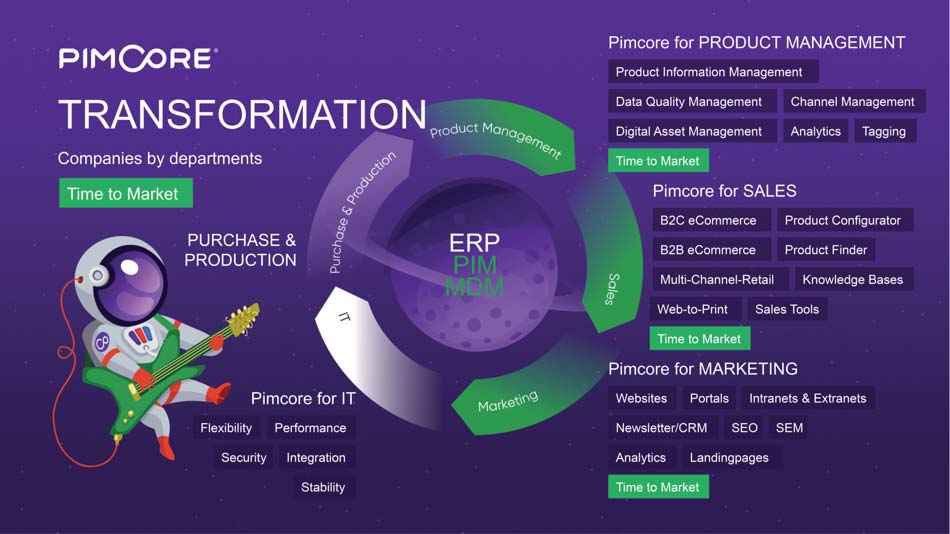Pimcore vs. WordPress which works best for enterprise?
Should you be using Pimcore or WordPress as an ecommerce solution for your enterprise business?
They both have their benefits, so for many enterprise companies. You can either choose one or the other. Or you can integrate Pimcore and WordPress so they can work together.

How does Pimcore differ from WordPress?
These two systems have been created with completely different objectives. Pimcore can help large organisations with complex data models and extensive product catalogues to coordinate all the key elements of the business. The activities Pimcore can handle include content management, marketing, asset management, ecommerce and customer experience.
WordPress, though much loved around the world, is essentially a targeted CMS software platform that provides a place for bloggers to post their content.
- Add-ins have enabled WordPress to expand their offering somewhat,
- However overall Pimcore has much greater capabilities to integrate and secure the handling of data.
Comparing blogging platforms
Pimcore and WordPress are not the only options in the blogging and ecommerce arena. Let us look at some of the other popular platforms you might com e across if you want to tackle blogging and sales.
Medium was launched back in 2012.
While it is less well known that WordPress, it has experienced steady growth and by 2017 was up to 60 million unique views a month. Medium will help you build a beautiful and professional-looking blog. It suits bloggers from a variety of industries who write about both niche and general interest topics.
LinkedIn also offers a blogging feature.
It is easy to use on a platform that is already established in the business and commerce worlds. If you already have a LinkedIn account you can get started right away- no registration or set up required. Simply select “write an article” and you are on your way.
LinkedIn blogs are well presented and readable. If you already have a lot of contacts and a wide network, you will have a ready audience. You won’t need to go chasing subscribers or followers. It does not really suit creative bloggers or free agents- it is primarily a way for businesses and professionals to share content and ideas.
Instagram could also be considered a blogging platform- albeit one based on the visual. Instagram ‘blogging’ can extend your reach and gain you followers and is a great way of showcasing your products in exciting, attractive and creative ways. The image announces your product story and the accompanying text, up to 2,200 characters, fills in the rest.
What is WordPress?
WordPress has been with us since the early 2000s, when it launched as a very basic open source CMS blogging tool. Recent data identified that each month, 70 million new posts are being created and 409 million people view more than 21 billion WordPress pages.
For some stats on WordPress, it is available in a large number of languages and enjoys a:
- 61.8% market share in the CMS blogging category.
- It is even visited more frequently than Twitter
- Almost 100 free themes allow bloggers to customise their pages.
And there are many more options available if you want to pay for a theme; currently, there are around 11,000 are listed for sale on Envato Market. Themes can help improve user experience by achieving better speed or point of sale services. Once established on WordPress, you can also move to self-hosted WordPress giving you a greater degree of autonomy.
WordPress gives decent content presentation, supported by optional themes and is used by a huge variety of writers and businesses around the globe. However, most WordPress users are running old versions, which makes us wonder about retention n rates. And while it is considered to be a pretty safe platform, there have been issues with data security and integrity. A lot of spam comments are also received across blogs on the site.
WordPress supports creative writers taking their first tentative steps into sharing their work. Enterprise and Fortune 500 companies like Sony Music also use it. They recognise the authenticity and direct address to customers that the platform can provide. WordPress can provide you a receptive community of readers, but ultimately, it is not particularly sophisticated in what it does.
What is WooCommerce?
WordPress users seeking to monetise their work have the option of expanding to WooCommerce, a popular WordPress plugin. WooCommerce enables you to operate an ecommerce service on your blog site. WooCommerce is used by around 70 million online shops and is used by just under a quarter of the top one million commerce sites across the globe. WooCommerce helps people convert their blogs into online stores.
What is Pimcore?
One platform for any digital data and customer experience. The Pimcore Platform™ is the only Enterprise Open Source software for managing any digital data and customer experiences for any channel and device. Pimcore is an open-source software system that combines numerous systems that many companies run as separate platforms.
Pimcore combines:
- Web content management software (CMS)
- Digital Experience (DX) Software
- E-commerce platforms (B2B/B2C)
- Digital Asset Management software (DAM)
- Product information management (PIM) software
- Master Data Management (MDM) software
- Customer Data Platform (CDP)
- Data Mapping Software
Pimcore consolidates information from multiple sources to provide a consistent user experience to customers. Pimcore’s ecommerce model has:
- Index Service
- Filter Service
- Price System
- Pricing Manager
- Voucher Systems
- Cart Manager
- Checkout Manager
- Payment Manager
- Order Manager

Comparison of WordPress WooCommerce and Pimcore
This G2 study compared WooCommerce with Pimcore, with Pimcore coming out on top in every single option in the Multi-Channel Support category including B2B features and mobile and customer service. It also came top in the following categories:
- Ease of Admin
- Quality of Support
- Ease of Doing Business With
- Product Direction (% positive)
- Storefront Design Tools
- Product Visualisation
- Recommendations / Personalisation
- Abandoned Cart Tools
- SEO
- Content Management
- Product Search and Filtering
- Shipping Options
- Customisation
- Security
- User Admin
Of the reviewers in this study, a higher percentage of Pimcore reviewers came from midmarket and Enterprise compared to the bulk of the WooCommerce respondents representing small businesses of less than 50 people. This demonstrates Pimcore’s suitability for larger-scale operations.
Ecommerce pros and cons of Pimcore and WordPress
The pros of WordPress are that it:
- Is very popular and well known
- Is SEO friendly
- Provides a decent range of free themes
- Supports many languages
- Has a website builder and expansion options
- Does not require you to know how to code
The cons of WordPress are that it:
- It is not really ideal for medium to large size businesses
- Has a high spam rate
- Has costs associated with customisation- to do a customised site could cost up to $50,000
- May use advertising on your pages
- Is more community mural than fine art- generally considered to be kind of rustic!
Also, WooCommerce is an add-on to an existing CMS. It was not designed and built from scratch as an ecommerce platform. It many ways is an add-on to a system initiated for a purpose completely different to generating sales. The ecommerce components of Pimcore are one part that makes it unique; it’s been fully designed in its own right to offer the best PIM for ecommerce.
The pros of Pimcore are that it:
- Is flexible and highly agile
- Multilingual
- Provides comprehensive product information management
- Handles content consistently and can cope with a huge number of file types
- Can deal with unique product data and combinations effectively
- Has complex product availability calculation
A Pimcore case study detailed the capabilities of one emerging trader’s site. This business stocked 250,000 products with multiple variations, and had more than 10,000 customers. Pimcore effectively kept track of sales, offers, prices and combinations with no problems. It’s skilled at dealing with businesses that have a big range.
Pimcore is also highly flexible as users can create personalised products novel ways of engaging and a playful approach to customers. It gives better options for B2B and especially for businesses trading in both B2B and B2C markets.
Customer expectations in ecommerce
Customer expectations in the online shopping environment are rapidly changing. Customers today expect:
- To have ready access to an entire catalogue before making a purchase decision
- Individual design and customisation options
- Extensive product selection choices
- Coupons and sales systems that work
- Smooth checkout process
- Trustworthy payment systems
- Flexibility in operation- performs well from the front while is complex behind the scenes
- Excellent presentation across all devices
- Intuitive interface
WordPress to Pimcore integration - How is it done?
The ecommerce component has been fully integrated into Pimcore 5 and beyond. By using the Pimcore WooCommerce Connector module, Pimcore can be aligned and integrated with WordPress commerce. This will allow you to get product data managed better than ever before.
The first step is to generate credentials in WooCommerce to allow the integration to occur. This basically means preparing for all of the existing data and records to be married up between the two platforms. An API key is used to fully enable access, meaning you can deal with products in Pimcore, enhancing the WooCommerce experience on the other side.
Once integrated, you will have access to outstanding Pimcore tools:
- Indexing
- Filtering
- Pricing
- Availability
- Carts
- Checkouts
- Vouchers
- Payments
- Order Management

Popular Pimcore plugins
If you want to invest in expanding your Pimcore architecture, there are a number of great plugins to help.
- CoreShop- a simple ecommerce tool with cart, quotes, order management and shipping services
- ImportDefinitions- giving more flexibility to the action of importing products
- ProcessManager- enabling customised task creation and management
- Pimcore-workflow-dashboard- assigning and monitoring workflows to the team
- Pimcore5-user-tracking- helping track customer interactions and requests
- Pimcore5-clipboard- flexibility for handling groups of products with special conditions
The bottom line:
WordPress certainly has its charm, and a niche position in the world of blogs. Its WooCommerce plugin is a great start if you want to use your blog for sales, but once you increase your product offerings, WooCommerce will find it hard to keep up. Combining Pimcore and WordPress will allow you to keep your WordPress fans and expand your product management capabilities exponentially.